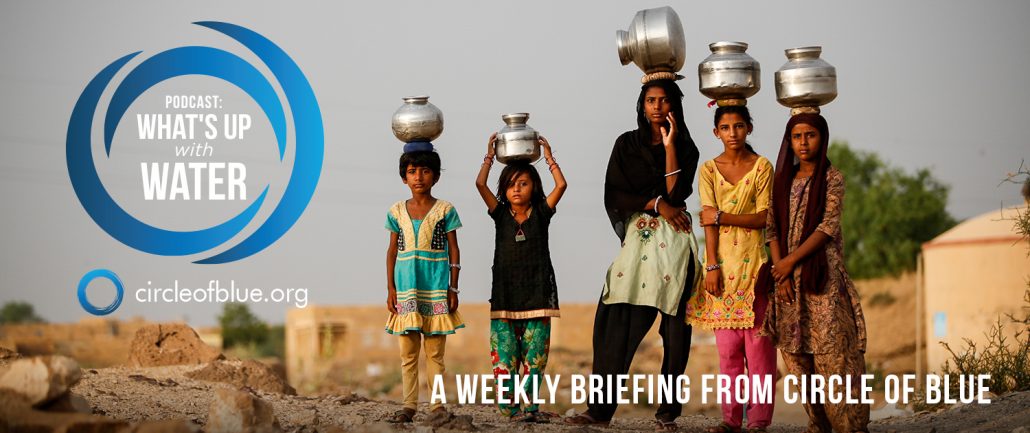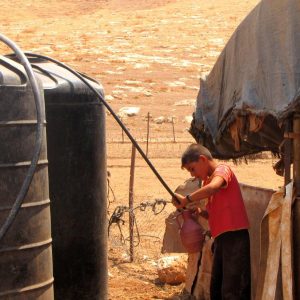
Transcripts
What’s Up With Water for March 26, 2018
I’m Eileen Wray-McCann, for Circle of Blue, and here’s What’s up with Water, a condensation of the world’s water news.
In Houston, Texas, the toxic effects of Hurricane Harvey are coming to light more than half a year after the petrochemical center was overcome by floodwaters.
The Associated Press and the Houston Chronicle examined county, state and federal records, which together revealed “a far more widespread toxic impact than authorities publicly reported after the storm.”
The Houston area hosts hundreds of chemical plants, ten refineries and thousands of miles of oil, gas and chemical pipelines. With destructive force, Hurricane Harvey flooded chemical facilities and refineries last August. Industrial wastewater, storm water, and dozens of tons of toxic materials, including known human carcinogens, were swept into surrounding neighborhoods and waterways. The reporters found over 100 Harvey-related toxic releases, onto land or into the air and water. Most, they say, were not publicized, and in the two major cases that were highlighted, the risks were initially understated. The reporters added that very few of the toxic industrial releases have seen federal investigation.
Local officials say that because Texas is disposed toward industry, it is hard for Houston and the surrounding areas to make a case to force companies, many with a history of pollution, to remediate their damage.
AP and the Houston Chronicle found that there was much less government testing after Hurricane Harvey compared to two other major Gulf Coast hurricanes in the past dozen years. Grant-funded researchers are trying to supplement environmental monitoring and a public health registry is planned to help people determine their exposure risks.
Scientists warn that the lack of data bodes poorly for efforts to weather the punishing storms that are predicted to be more frequent in the future.
In other U.S. news, Wildfires dramatically affect watersheds – this, from the American Chemical Society’s annual meeting last week. The Society is a non-profit organization and a leading source of scientific inquiry. The report follows the largest wildfire in California’s modern history and has widespread implications as forested watersheds supply almost two-thirds of drinking water sources in the U.S.
The report says that as soil warms, it releases more chemical compounds. Because of this, fires in watershed forests have a “variable but predictable” effect on the release of materials in the soil that then make their way into drinking water. The type and the amount of these released substances depends on the severity of the fire.
Wildfires can alter water quality by increasing nutrients, sediments and dissolved organic carbon. Carbon and nitrogen-containing compounds can react with chemicals that are used by utilities to purify water. This can create “disinfection byproducts” which can be harmful to human health and are regulated by the Environmental Protection Agency.
The researchers say the data will illuminate the effects of wildfires on water quality and on the processing of drinking water. They expect further application as wildfires increase due to climate change, drought, land disturbance and increased fuel loads.
Climate disasters and conflict are leading to higher levels of acute hunger says a new report from the United Nations. According to the report, in 2017 some 124 million people across 51 countries endured a hunger crisis, an increase of 11 million from the year before.
The Global Report on Food Crises says the increase in food emergencies is largely due to multiple, interlinking, and often concurrent factors. Conflict and extreme climate events such as drought top the list, along with high prices for staple foods.
Conflict remains the main cause for critical food insecurity in 18 countries, of which 15 are in Africa or the Middle East. The report draws on regional and national data from many sources. The UN says that it shows the need not just for humanitarian aid, but for preventive action to address the root causes of hunger and vulnerability.
Al Jazeera reports that despite the government’s efforts, over half of Kenya’s population does not have safe drinking water and that many are forced to use contaminated sources such as ponds, shallow wells, and even puddles.
Catherine Soi , a journalist in northeastern Kenya, says that many communities rely on freshwater deliveries from distant bore holes, but the water trucks come only sporadically. The rain is erratic as well, and people travel great distances to find water and food for themselves and their livestock. Conflicts over water and pasture rise as water scarcity increases, and the traditional ways of sharing resources are hampered by political interference.
The Kenyan government and aid organizations are drilling wells, building dams and using other methods to supply water, but it is becoming ever more elusive. The water table in some areas has dropped to more than 160 feet below the surface.
Vietnam’s Ministry of Natural Resources and Environment recently held a workshop called “Green Solutions for Water Resources” in an effort to manage serious threats to its water sustainability.
Water pollution is a key concern in Vietnam, said officials. The country’s wastewater treatment is the lowest of the surrounding countries, and it faces a significant agricultural and economic threat by weather disturbances such as flooding.
Nearly 70 per cent of Vietnam’s water comes from outside the country, and water management has become increasingly urgent. Some specialists emphasize the need to supplement policy and regulation with principles of market economy.
And that’s What’s Up With Water…We’d like to share what’s up where you are – Tweet us with your water news: @circleofblue #whatsupwithwater.
Eileen Wray-McCann is a writer, director and narrator who co-founded Circle of Blue. During her 13 years at Interlochen Public Radio, a National Public Radio affiliate in Northern Michigan, Eileen produced and hosted regional and national programming. She’s won Telly Awards for her scriptwriting and documentary work, and her work with Circle of Blue follows many years of independent multimedia journalistic projects and a life-long love of the Great Lakes. She holds a BA and MA radio and television from the University of Detroit. Eileen is currently moonlighting as an audio archivist and enjoys traveling through time via sound.



